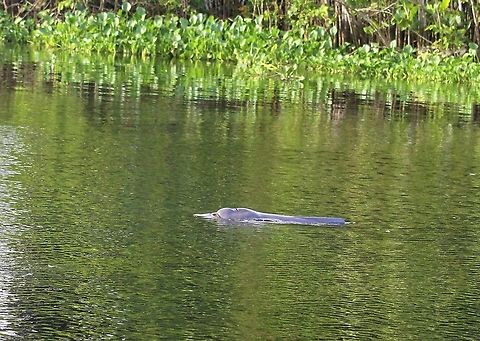
Appearance
The Amazon river dolphin is the largest river dolphin. Adult males reach a maximum length and weight of 2.55 metres and 185 kilograms, while females reach a length and weight of 2.15 metres and 150 kilograms. It has very evident sexual dimorphism, with males measuring and weighing between 16% and 55% more than females, making it unique among cetaceans, where females are generally larger than males.The texture of the body is robust and strong but flexible. Unlike oceanic dolphins; the cervical vertebrae are not fused, allowing the head to turn 90 degrees. The flukes are broad and triangular, and the dorsal fin, which is keel-shaped, is short in height but very long, extending from the middle of the body to the caudal region. The pectoral fins are large and paddle-shaped. The length of its fins allows the animal to perform a circular movement, allowing for exceptional maneuverability to swim through the flooded forest but decreasing its speed.
The body color varies with age. Newborns and the young have a dark grey tint, which in adolescence transforms into light grey, and in adults turns pink as a result of repeated abrasion of the skin surface. Males tend to be pinker than females due to more frequent trauma from intra-species aggression. The color of adults varies between solid and mottled pink and in some adults the dorsal surface is darker. It is believed that the difference in color depends on the temperature, water transparency, and geographical location. There is one albino on record, kept in an aquarium in Germany.
The skull of the species is slightly asymmetrical compared to the other toothed whales. It has a long, thin snout, with 25 to 28 pairs of long and slender teeth to each side of both jaws. Dentition is heterodont, meaning that the teeth differ in shape and length, with differing functions for both grabbing and crushing prey. Anterior teeth are conical and later have ridges on the inside of the crown. Despite small eyes, the species seems to have good eyesight in and out of the water. It has a melon on the head, the shape of which can be modified by muscular control when used for biosonar. Breathing takes place every 30 to 110 seconds.
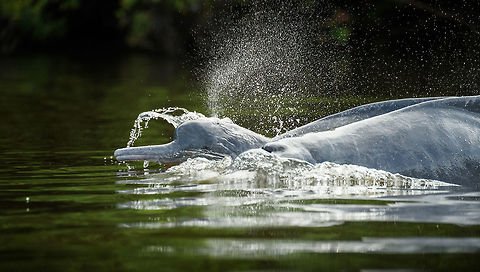
Naming
''Inia geoffrensis geoffrensis'' inhabits most of the Amazon River, including rivers Tocantins, Araguaia , low Xingu and Tapajos, the Madeira to the rapids of Porto Velho, and rivers Purus, Yurua, Ica, Caqueta, Branco, and the Rio Negro through the channel of Casiquiare to San Fernando de Atabapo in the Orinoco river, including its tributary: the Guaviare.''Inia humboldtiana geoffrensis'' are located in the Orinoco River basin, including the Apure and Meta rivers. This subspecies is restricted, at least during the dry season, to the waterfalls of Rio Negro rapids in the Orinoco between Samariapo and Puerto Ayacucho, and the Casiquiare canal.
''Inia geoffrensis boliviensis'' has populations in the upper reaches of the Madeira River, upstream of the rapids of Teotonio, in Bolivia. It is confined to the Mamore River and its main tributary, the Iténez.
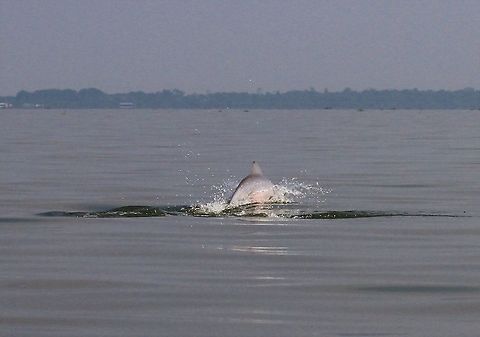
Distribution
Amazon river dolphins are the most widespread river dolphins. They are present in six countries in South America: Bolivia, Brazil, Colombia, Ecuador, Peru, and Venezuela, in an area covering about 7,000,000 square kilometres . The boundaries are set by waterfalls, such as the Xingu and Tapajós rivers in Brazil, as well as very shallow water. A series of rapids and waterfalls in the Madeira River have isolated one population, recognized as the subspecies ''I. g. boliviensis'', in the southern part of the Amazon basin in Bolivia.They are also distributed in the basin of the Orinoco River, except the Caroni River and the upper Caura River in Venezuela. The only connection between the Orinoco and the Amazon is through the Casiquiare canal. The distribution of dolphins in the rivers and surrounding areas depends on the time of year; in the dry season they are located in the river beds, but in the rainy season, when the rivers overflow, they disperse to the flooded areas, both the forests and the plains.
Studies to estimate the population are difficult to analyze due to the difference in the methodology used. In a study conducted in the stretch of the Amazon called Solimões River, with a length of 1,200 kilometres between the cities of Manaus and Tabatinga, a total of 332 individuals was sighted ± 55 per inspection. Density was estimated at 0.08- 0.33 animals per square kilometer in the main channels, and 0.49 to 0.93 animals per square kilometer in the branches. In another study, on a stretch of 120 kilometres at the confluence of Colombia, Brazil and Peru, 345 individuals with a density of 4.8 per square km in the tributaries around the islands. 2.7 and 2.0 were observed along the banks. Additionally, another study was conducted in the Amazon at the height of the mouth of the Caqueta River for six days. As a result of the studies conducted, it was found that the density is higher in the riverbanks, 3.7 per km, decreasing towards the center of the river. In studies conducted during the rainy season, the density observed in the flood plain was 18 animals per square km, while on the banks of rivers and lakes ranged from 1.8 to 5.8 individuals per square km. These observations suggest that the Amazon river dolphin is found in higher density than any other cetacean.
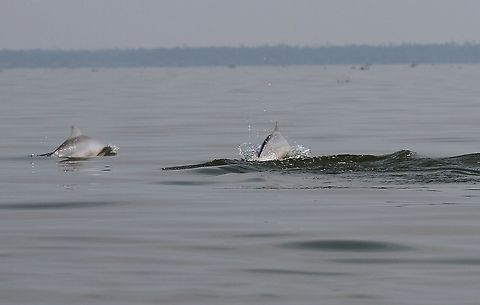
Status
In 2008, the International Whaling Commission expressed concern for captured botos for use as bait in the Central Amazon, which is an emerging problem that has spread on a large scale. The species is listed in Appendix II of the Convention on International Trade in Endangered Species Fauna and Flora , and Appendix II of the Convention on the Conservation of Migratory Species of Wild Animals, because it has an unfavorable conservation status or would benefit significantly from international co-operation organized by tailored agreements.According to a previous assessment by the Scientific Committee of the International Whaling Commission in 2000, the population of botos appears great and there is little or no evidence of population decline in numbers and range. However, increased human intervention on their habitat is expected to, in the future, be the most likely cause of the decline of its range and population. A series of recommendations were issued to ensure proper follow-up to the species, among which is the implementation and publication of studies on the structure of populations, making a record of the distribution of the species, information about potential threats as the magnitude of fishing operations and location of pipelines.
In September 2012, Bolivian President Evo Morales enacted a law to protect the dolphin and declared it a national treasure.
In 2008, the species was listed on the Red list of endangered species, but in 2011, the IUCN stated it as Data Deficient . The species was previously listed as "vulnerable" but the conservation status changed due to the limited amount of currently available information on threats, ecology, and population trends. In areas where these dolphins have been studied, they appear well extended and relatively abundant. However, these areas represent only a small proportion of the total distribution of the species and are often sites where the animals are protected. Consequently, the information from these areas may not be representative, and may not be valid in the long term.
Increasing pollution and gradual destruction of the Amazon rainforest add to the vulnerability of the species. The biggest threats are deforestation and other human activities that contribute to disrupt and alter their environment. Another source of concern is the difficulty in keeping these animals alive in captivity, due to intra-species aggression and low longevity. Captive breeding is not considered a conservation option for this species.
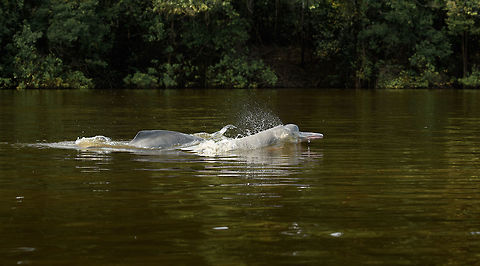
Behavior
The Amazon river dolphin are commonly seen singly or in twos, but may also occur in pods that rarely contain more than eight individuals. Pods as large as 37 individuals have been seen in the Amazon, but average is three. In the Orinoco, the largest observed groups number 30, but average is just above five. Typically, social bonds occur between mother and child, but may also been seen in heterogeneous groups or bachelor groups. The largest congregations are seen in areas with abundant food, and at the mouths of rivers. There is significant segregation during the rainy season, with males occupying the river channels, while females and their offspring are located in flooded areas. However, in the dry season, there is no such separation....hieroglyph snipped... Due to the high level of prey fish, larger group-sizes are seen in large sections that are directly influenced by whitewater than in smaller sections influenced by blackwater . In their freshwater habitat they are apex predators and gatherings depend more on food sources and habitat availability than in oceanic dolphins where protection from larger predators is necessary.Captive studies have shown that the Amazon river dolphin is less shy than the bottlenose dolphin, but also less sociable. It is very curious and has a remarkable lack of fear of foreign objects. However, dolphins in captivity may not show the same behavior that they do in their natural environment, where they have been reported to hold the oars of the fishermen, rub against the boat, pluck underwater plants, and play with sticks, logs, clay, turtles, snakes, and fish.
They are slow swimmers; they commonly travel at speeds of 1.5 to 3.2 kilometres per hour but have been recorded to swim at speeds up to 14 to 22 kilometres per hour . When they surface, the tips of the snout, melon and dorsal fins appear simultaneously, the tail rarely showing before diving. They can also shake their fins, and pull their tail fin and head above the water to observe the environment. They occasionally jump out of the water, sometimes as high as a meter . They are harder to train than most other species of dolphin.Like other dolphins, river dolphins use whistling tones to communicate. The issuance of these sounds is related to the time they return to the surface before diving, suggesting a link to food. Acoustic analysis revealed that the vocalisations are different in structure from the typical whistles of other species of dolphins....hieroglyph snipped...
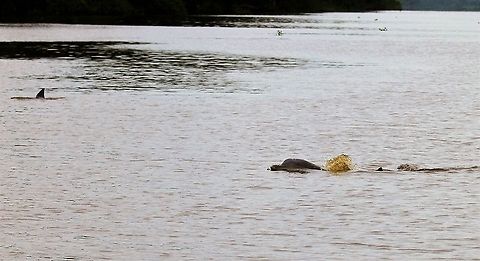
Habitat
The Amazon river dolphin is located in most of the area's aquatic habitats, including; river basins, major courses of rivers, canals, river tributaries, lakes, and at the ends of rapids and waterfalls. Cyclical changes in the water levels of rivers take place throughout the year. During the dry season, dolphins occupy the main river channels, and during the rainy season, they can move easily to smaller tributaries, to the forest, and to floodplains.Males and females appear to have selective habitat preferences, with the males returning to the main river channels when water levels are still high, while the females and their offspring remain in the flooded areas as long as possible; probably because it decreases the risk of aggression by males toward the young and predation by other species.
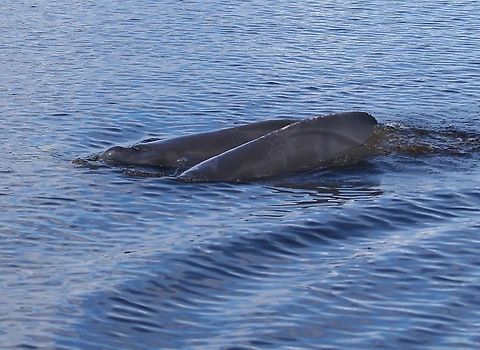
Reproduction
Breeding is seasonal, and births occur between May and June. The period of birthing coincides with the flood season, and this may provide an advantage because the females and their offspring remain in flooded areas longer than males. As the water level begins to decrease, the density of food sources in flooded areas increases due to loss of space, providing enough energy for infants to meet the high demands required for growth. Gestation is estimated to be around eleven months and captive births take 4 to 5 hours. At birth, calves are 80 centimetres long and in captivity have registered a growth of 0.21 metres per year. Lactation takes about a year. The interval between births is estimated between 15 and 36 months, and the young dolphins are thought to become independent within two to three years.The relatively long duration of breastfeeding and parenting suggests a strong mother-child bond. Most couples observed in their natural environment consist of a female and her calf. This suggests that long periods of parental care contribute to learning and development of the young.
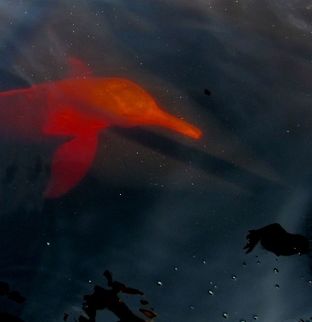
Food
The diet of the Amazon river dolphin is the most diverse of the toothed whales. It consists of at least 53 different species of fish, grouped in 19 families. The prey size is between 5 and 80 centimetres , with an average of 20 centimetres . The most frequently consumed fish belong to the families Sciaenidae , Cichlidae, and Characidae . The dolphin’s dentition allows it to access shells of river turtles and freshwater crabs. The diet is more diverse during the wet season, when fish are spread in flooded areas outside riverbeds, thus becoming more difficult to catch. The diet becomes more selective during the dry season when prey density is greater.Usually, these dolphins are active and feeding throughout the day and night. However, they are predominantly crepuscular. They consume about 5.5% of their body weight per day. They sometimes take advantage of the disturbances made by boats to catch disoriented prey. Sometimes, they associate with the distantly-related tucuxi , and giant otters to hunt in a coordinated manner, by gathering and attacking fish stocks at the same time. Apparently, there is little competition for food between these species, as each prefers different prey. It has also been observed that captive dolphins share food.
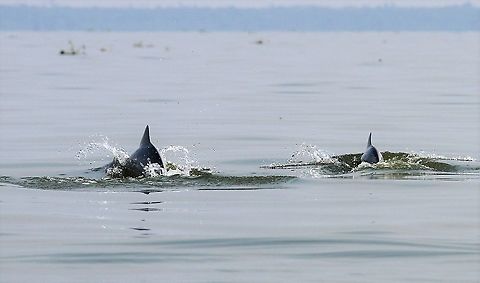
Predators
The region of the Amazon in Brazil has an extension of 5,000,000 km2 containing diverse fundamental ecosystems. One of these ecosystems is a floodplain, or a várzea forest, and is home to a large number of fish species which are an essential resource for human consumption. The várzea is also a major source of income through excessive local commercialized fishing. Várzea consists of muddy river waters containing a vast number and diversity of nutrient rich species. The abundance of distinct fish species lures the Amazon River dolphin into the várzea areas of high water occurrences during the seasonal flooding.In addition to attracting predators such as the Amazon river dolphin, these high-water occurrences are an ideal location to draw in the local fisheries. Human fishing activities directly compete with the dolphins for the same fish species, the tambaqui and the pirapitinga , resulting in deliberate or unintentional catches of the Amazon river dolphin. The local fishermen overfish and when the Amazon River dolphins remove the commercial catch from the nets and lines, it causes damages to the equipment and the capture, as well as generating ill will from the local fishermen.
The negative reactions of the local fishermen are also attributed to the Brazilian Institute of Environment and Renewable Natural Resources prohibition on killing the Amazon river dolphin, yet not compensating the fishermen for the damage done to their equipment and catch.
During the process of catching the commercialized fish, the Amazon river dolphins get caught in the nets and exhaust themselves until they die, or the local fishermen deliberately kill the entangled dolphins. The carcasses are discarded, consumed, or used as bait to attract a scavenger catfish, the piracatinga . The use of the Amazon river dolphin carcass as bait for the piracatinga dates back to 2000. Increasing demand for the piracatinga has created a market for distribution of the Amazon river dolphin carcasses to be used as bait throughout these regions.
Of the 15 dolphin carcasses found in the Japurá River in 2010–2011 surveys, 73% of the dolphins were killed for bait, disposed of, or abandoned in entangled gillnets. The data do not fully represent the actual overall number of deaths of the Amazon river dolphins, whether accidental or intentional, because a variety of factors make it extremely complicated to record and medically examine all the carcasses. Scavenger species feed upon the carcasses, and the complexity of the river currents make it nearly impossible to locate all of the dead animals. More importantly, the local fishermen do not report these deaths out of fear that a legal course of action will be taken against them, as the Amazon river dolphin and other cetaceans are protected under a Brazilian federal law prohibiting any takes, harassments, and kills of the species.
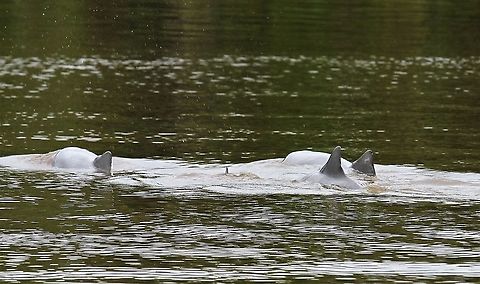
Migration
In the Pacaya-Samiria National Reserve, Peru, photo-identification is used to recognize individuals based on pigmentation patterns, scars and abnormalities in the beak. 72 individuals were recognized, of which 25 were again observed between 1991 and 2000. The intervals between sightings ranged from one day to 7.5 years. The maximum range of motion was 220 kilometres , with an average of 60.8 kilometres . The longest distance in one day was 120 kilometres , with an average of 14.5 kilometres ....hieroglyph snipped... In a previous study conducted at the center of the Amazon River, a dolphin was observed that moved only a few dozen kilometers from the dry season and wet season. However, three of the reviewed 160 animals were observed over 100 kilometres from where they were first registered.References:
Some text fragments are auto parsed from Wikipedia.